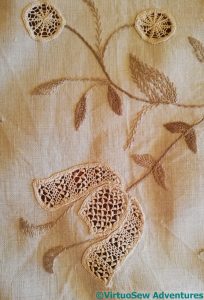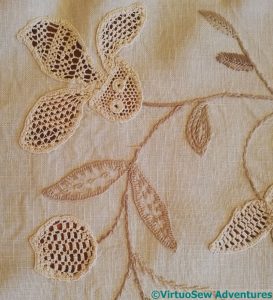A Source of Inspiration (2)
The Spiders Web Wheels in this case aren’t Spiders Web Wheels at all, but a needlelace variation. I think they are both worked in a spiral, and I’m not absolutely sure that they are the same: the slight difference in appearance may be purely a result of a different working tension or spacing.
I’ve only just realised that the small leaves aren’t worked stacked fly stitches, but in close, long-armed feather stitch. In fact feather stitches and their variations show up a lot in Grandmama’s embroidery – she must have enjoyed them!
I don’t think it has ever occurred to me to work needlelace stitches in bands, as she has here, but I can see myself trying it, one of these days! I do have a book, somewhere, full of needlelace stitches, ready for when I have a suitable project and the opportunity to Experiment…
When I was working on the lifebelts for the ship in “Leaving The Tyne”, I used the technique of a buttonhole wheel on thread, and discovered just how fiddly they are to make. Grandmama’s are even smaller and fiddlier, and sewn onto needlelace and not fabric!
The two embroidered leaves in the middle remind me just how effective simple stitch length variation can be. Much as I love my complex, textural stitches, sometimes all you need for a border is a blanket stitch variation!
The variations possible to fill a circular shape seem to be endless, don’t they – a sort of beginning of a Maltese Cross at the top, a really dense Spiders Web at the bottom.
And this time, I think the two central leaves are in Wheatear Stitch, outlined with very close and small feather stitch outlines.
I really must try some of Grandmama’s stitches one of these days. Somewhere in the house I have the notes she took on a course, and I’m pretty sure they included sketches of stitches I haven’t seen in all my shelves full of needlework books….




If I remember rightly, spider’s web starts swirling from the middle with the design defined. The other fillings begin at the edge with loops of equal sizes, in the first example, and a group of four or five close loops followed by a bigger one in the second. You then loop into the existing loops to create your pattern. These are difficult because maintaining the correct tension at each stage depends on accuracy of eye. The wheels often look like a jumble of thread (all those loops) until the centre is reached and and the final tension creates the design. Mam’s notes take some deciphering!
I still think the ‘wheatear’ is a slight variant, not the standard book version. I shall continue experimenting… but the outline around that stitch is definitly not close feather. It is either cable plait or cable chain (gordian knot) stitch. I think your Grandmama is having fun with some Mountmellick stitches on this piece. If you have Weldon’s look at their Mountmellick section. The lace fillings are very good. I do like the simple spiderweb ones.
You are so lucky to have these pieces to refer to. But it just makes one realise the importance of keeping notes about our work, which non of us every really do. If I am preparing a piece for a class I will but not things I do for myself. We think what we do isn’t important but who knows who will refer to our work in the future?
So gorgeous! I love that there are notes from your grandmother’s work on her piece. So…at least three generations of embroiderers!
I agree with Sue that the wheatear isn’t a standard wheatear as it looks like the chain is marching the opposite way. It could be a chain on top of fly, or maybe just a turn of the ears of the wheatear stitch in the opposite direction. My guess of the border is also cable chain.
I don’t know anything about needlelace yet but now I will hunt for books!
I love that you posted this. It is beautiful, but I also recently went through a gifted treasure of mine and tried to determine the stitches of a crazy quilt my family had used. It made for quite a delightful journey and there are a few stitches I still need to sort out. Seeing you do the same is fun:)
Very nice.
It’s a delight to zoom in on the pictures and look closely at the stitches.
I agree with Carolyn that we should keep a record of our work, but unfortunately seldom do.
Love the look of the needle lace